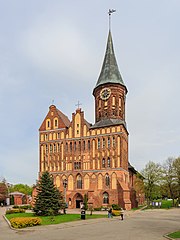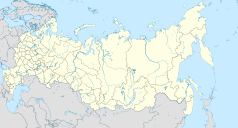Katedra Matki Bożej i św. Wojciecha w Kaliningradzie
| katedra | |||||||||||||||||
 Elewacja zachodnia katedry | |||||||||||||||||
| Państwo | |||||||||||||||||
|---|---|---|---|---|---|---|---|---|---|---|---|---|---|---|---|---|---|
| Obwód | |||||||||||||||||
| Miejscowość | |||||||||||||||||
| Wyznanie | katolickie (1333–1525) protestanckie (1525–1945) | ||||||||||||||||
| Kościół | |||||||||||||||||
| Wezwanie | |||||||||||||||||
| |||||||||||||||||
| |||||||||||||||||
| Strona internetowa | |||||||||||||||||
Katedra w Kaliningradzie (ros. Кафедральный собор в Калининграде[1][2], Домский собор Богоматери и Святого Адальберта[3], niem. Königsberger Dom) – dawniej główna świątynia w Kaliningradzie (do 1946 Królewiec), znajdująca się w historycznej części miasta Knipawa. Katedra została wzniesiona w stylu gotyckim w 1333 r. i jest jedną z nielicznych, okazałych budowli, które zachowały się z przedwojennej architektury miasta. Początkowo kościół katolicki był siedzibą biskupów sambijskich, od 1525 do 1945 r. był świątynią luterańską. Obecnie katedra pełni funkcję centrum religijnego i kulturowego miasta. W katedrze mieszczą się m.in. czasownia prawosławna, kaplica protestancka, muzeum budynku, muzeum Immanuela Kanta. W katedrze odbywają się koncerty muzyki poważnej i religijnej, okazjonalnie nabożeństwa katolickie, prawosławne i protestanckie.
Historia
Powstanie katedry
Poprzednik katedry, mały kościółek, został wzniesiony w południowo-wschodniej części Starego Miasta w latach 1297–1302. Inicjatorem budowy nowej świątyni był biskup Sambii Jan Clare. W 1327 r. Wielki Mistrz zakonu krzyżackiego, Werner von Orseln przekazał grunt leżący na wyspie Knipawie między ramionami Pregoły pod budowę nowej katedry.
Około 1330 r. (dokładna data jest nieznana) rozpoczęto prace budowlane. Pierwotnie zamierzano wznieść kościół obronny z grubymi murami i okienkami strzelniczymi. Jednak zakon krzyżacki nie zezwolił na to żeby w pobliżu Zamku powstała twierdza i wstrzymano budowę. 13 września 1333 r. biskup podpisał umowę pomiędzy Zakonem i Kościołem dotyczącą budowy katedry i od tego momentu kontynuowano budowę tylko świątyni bez obronnych umocnień. Ta data jest uznawana za początek budowy katedry królewieckiej.
Teren na wyspie był bagnisty i przez to budowniczy musieli najpierw wbić w ziemię setki dębowych pali, zanim można było zacząć właściwą budowę. Katedra na Starym Mieście została rozebrana i uzyskane w ten sposób materiały budowlane można było użyć do budowy nowej na wyspie. Specjalnie dla transportu materiału została wzniesiona w murach miejskich Starego Miasta nowa brama i nowy most.
Most został po zakończeniu budowy rozebrany, natomiast brama została zachowana i istniała przez sześć wieków. Po stosunkowo krótkim czasie 50 lat katedra została w 1380 r. w dużym stopniu ukończona. Praca nad freskami wewnątrz katedry trwała jeszcze do końca XIV wieku.
Późniejsze przebudowy
Około 1440 r. katedra została przebudowana na kościół halowy. W nawie głównej założono sklepienia gwieździste, natomiast w nawach bocznych sklepienie trójdzielne. Podwyższono wtedy wieże zachodnie. Spłonęły one w 1544 r. Po tym pożarze odbudowano tylko południową, a pozostałości wieży północnej przykryto prostym dachem. W 1640 na wieży południowej zawieszono zegar. Od 1650 w wieży północnej znajdowała się Biblioteka Wallenrodzka. W 1695 r. katedra otrzymała organy. Podczas restauracji w latach 1901–1907 przywrócono fasadzie zachodniej wygląd z XIV wieku.
Do II wojny światowej katedra miała następujące rozmiary:
- długość: 88,5 m;
- wysokość południowej wieży: 50,75 m;
- wysokość nawy głównej: 32,14 m.
Zniszczenia II wojny światowej
W wyniku nalotów alianckich w czasie II wojny światowej katedra została w znacznym stopniu zniszczona. W latach 70. XX wieku mury częściowo zabezpieczono i pozostawiono w formie trwałej ruiny. W 1992 r. rozpoczęto odbudowę katedry finansowaną głównie z funduszy niemieckich. Po odbudowie katedra ma stać się salą koncertową, gdyż strona rosyjska nie zgadza się na przywrócenie jej funkcji sakralnych. Pracami od początku kieruje inżynier budowlany Igor Odincow.
Pochowani

Katedra była miejscem spoczynku wielkich mistrzów krzyżackich, książąt pruskich i profesorów uniwersytetu. Koronacje natomiast odbywały się na zamku.
W ścianie wschodniej prezbiterium zachowała się część pomnika grobowego księcia Albrechta z 1572 r. oraz wykonane w alabastrze, późniejsze epitafium Bogusława Radziwiłła i jego żony Anny Marii. Oba zostały odrestaurowane w 2009 r.
W XVI–XVIII w. odbywały się tu – obok niemieckich – także polskie nabożeństwa ewangelickie, odprawiane od 1529 r. przez ks. Jana Wnorowskiego, a następnie przez duchownych z kościoła św. Mikołaja na Steindamm.
Wybrani pochowani:
- Luther z Brunszwiku
- Ludwig von Erlichshausen
- Henryk VI Reuss von Plauen
- Henryk VII Reffle von Richtenberg
- Martin Truchsess von Wetzhausen
- Johann von Tieffen
- Albrecht Hohenzollern
- Jerzy Wilhelm Hohenzollern
- Anna Maria Radziwiłł
- Bogusław Radziwiłł
- Immanuel Kant
Przypisy
- ↑ Кафедральный собор в Калининграде. Кафедральный собор Калининград, sobor-kaliningrad.ru [dostęp 2016-05-14].
- ↑ И. А. Одинцов, директор Государственного музейного комплекса «Кафедральный собор», г. Калининград—Кёнигсберг. «Восставший из руин». История Кафедрального собора в Калининграде. Статья из периодического издания Европейского союза независимых журналистов «Объектив» (№ 1(6), январь 2014 года). // sobor-kaliningrad.ru
- ↑ Калининград (бывший Кёнигсберг) – «БРЭ», Большая российская энциклопедия [dostęp 2016-05-14].
Bibliografia
- Caspar Stein, Das Alte Königsberg. Eine ausführliche Beschreibung der drei Städte Königsberg... anno 1644, Hamburg, Verein für Familienforschung in Ost- und Westpreussen, 1998, ISBN 3-931577-14-7 (reprint wyd. Königsberg 1911)
- Dehio-Handbuch der Kunstdenkmäler West- und Ostpreussen. Die ehemaligen Provinzen West- und Ostpreussen (Deutschordensland Preussen) mit Bütower und Lauenburger Land, bearb. von Michael Antoni, München; Berlin, Dt. Kunstverl., 1993, ISBN 3-422-03025-5
- Baldur Köster, Königsberg. Architektur aus deutscher Zeit, Husum, Husum, 2000, ISBN 3-88042-923-5
- Igor Aleksandrovič Odincov, Kafedral'nyj sobor v Kaliningrade, nauč. red. I. S. Kuznecova, Kaliningrad, Jantarnyj skaz, 2005 (Игор Александрович Одинцов, Кафедральный собор в Калинингрaде, науч. peд. И. С. Куэнецова, Kалининград, Яантарный скаэ, 2005) = Igor Odinzow, Der Königsberger Dom, wiss. Red. Irina Kusnezowa, Kaliningrad, Jantarnyj Skaz, 2005, ISBN 5-7406-0931-4
- Prusy Wschodnie – dokumentacja historycznej prowincji. Zbiory fotograficzne dawnego Urzędu Konserwatora Zabytków w Królewcu = Ostpreussen – Dokumentation einer historischen Provinz. Die photographische Sammlung des Provinzialdenkmalamtes in Königsberg, oprac. i red. bazy danych Jan Przypkowski, Warszawa, Instytut Sztuki PAN, [2006], ISBN 83-89101-44-0
Linki zewnętrzne
Media użyte na tej stronie
Autor: Uwe Dedering, Licencja: CC BY-SA 3.0
Location map of Russia.
EquiDistantConicProjection : Central parallel :
* N: 54.0° N
Central meridian :
* E: 100.0° E
Standard parallels:
* 1: 49.0° N * 2: 59.0° N
Made with Natural Earth. Free vector and raster map data @ naturalearthdata.com.
Because the southern Kuril islands are claimed by Russia and Japan, they are shown as disputed. For more information about this see: en:Kuril Islands dispute. These islands are since 1945 under the jurisdiction of the Russian Federation.
Autor: NordNordWest, Licencja: CC BY-SA 3.0
Location map of the Kaliningrad Oblast, Russia
Blue Shield - the Distinctive emblem for the Protection of Cultural Property. The distinctive emblem is a protective symbol used during armed conflicts. Its use is restricted under international law.
Königsberg, Dom, Denkmal des BOGUSLAUS RADZIWILL, 1669
Autor: Зандер виктор, Licencja: CC BY-SA 4.0
The oldest Cathedral Church in königsberg was built by Bishop Siegfried Samland, between the years 1297-1302 in the area between the rivers Pregel and Leba. Already in 20-ies of the XIV century it was small for a Cathedral, through the initiative of Bishop Johann in the North-Eastern corner of the area Kneiphof was the construction of a new Cathedral. As a documentary Foundation date of the Cathedral, was adopted on 13 September 1333, when the Comptroller of Luther agreed to the continuation of construction, but in fact it was started before. The new Cathedral was dedicated, judging by the chronicle of 1335, Vysokoosnaschennoe the body of Jesus Christ and chronicle the year 1421, the virgin Mary, All saints and St. albert. In 1523, the Cathedral hosted the first in königsberg Evangelical preaching Johann Brisman. In 1528, the Cathedral became the property of district of Kneiphof. As the Cathedral of East Prussia, he served as the burial place of the most prominent representatives of the higher secular and spiritual hierarchies, gentle nobility. In the Cathedral there were more than hundred gravestones and epitaphs, placed inside and outside the building. They were made at different times and at different artistic levels. The first burial dates to 1335: the grave of the founder of the Cathedral, Grand master of the Teutonic order of Luther von Braunschweig. The last burial— presumably to 1809 — stillborn son of Prince William and his wife Marianne, Princess of Hesse-Hamburg. Here were buried the great masters of the Teutonic order, the bishops Samland, including prominent dignitaries of the order and the Grand Duchy of königsberg University Professor, members of their families. In 1588, the Northern part of the altar based Professor's burial. At the North-Eastern corner of the Cathedral on 28 February 1804, buried by the great German philosopher Immanuel Kant. In 1924, in connection with the 200th anniversary from the day of his birth, Koenigsberg architect Friedrich Lars on the grave was erected a portico, preserved to the present time. Tombstone and portico made the Konigsberg company Otto Pehta.
Currently on the South side adjacent to the Cathedral site, the so-called "Bishop's square", there is the grave and tombstone of Julius Rupp (1809-1884), the founder of the "Free Catholic-Evangelical community", leader of the democratic movement of 40-ies of the XIX century, member of the Prussian Parliament in 1849-1862., native grandfather of the famous revolutionary artist K. Kollwitz. Many students J. Rupp became active social Democrats. In the North tower of the Cathedral in 1650 Chancellor Martin von Wallenrodt founded vallenrod's library. It consisted of about 10 thousand volumes, and occupied one room. In this library were manuscripts focused on the history of Prussia and of noble families. In 1591 built all the chancel and made a new altar, the decoration of which was done by the artist Lucas Cranach the of Wittenberge. In 1721 the Cathedral was erected a large organ, and in 1888 he was replaced by M. Terletskii. In 1833, in connection with the 500th anniversary, the entire Cathedral was renovated. Over the centuries, the Cathedral burned down several times and rebuilt. During the Second world war in 1941-1945 he had been badly damaged by flying British aircraft, as well as fires. The interior was not preserved, and the stone tombs and slabs with epitaphs have been preserved only partially.
Despite significant damage, the former Cathedral is among the most oldest monuments of religious architecture and has great architectural and historical value. The Cathedral is a building of Basilica type, with three aisles and a nave altar. To the West of the Cathedral culminates in a unique for the North German typical Gothic part of the tower, consisting of multi-faceted South tower, North tower and deck of the porch between the towers. During its long history the Cathedral was repeatedly rebuilt and repaired. In the postwar years, the Cathedral continued to deteriorate and its technical condition has steadily deteriorated. In 1981— 1984 years was made part of the conservation works that helped preserve the ruins of the Cathedral.
Since 1994 the firm "Cathedral" started work on the restoration of the Cathedral.Autor: Huhu Uet, Licencja: CC BY-SA 3.0
Impressionen aus Kaliningrad (früher Köningsberg) während einer Fahrt durch die Stadt im Jahr 1982. Alle Bilder wurden mit einer Analogen Kamera augenommen und von einem Kleinbild Negativ reproduziert
Autor: A.Savin, Licencja: FAL
Historical Lutheran cathedral in Kaliningrad formerly Königsberg, Kaliningrad Oblast (Russia).














